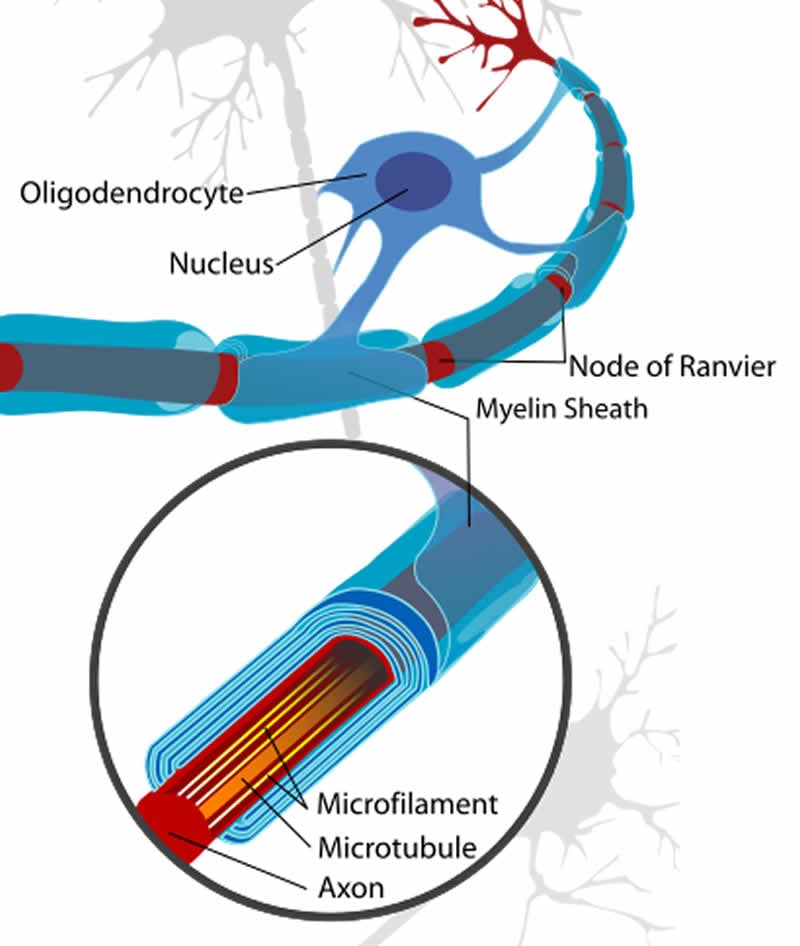Brain cell insulation abnormalities caused in part by genes.
Schizophrenia is one of the most disabling of all psychiatric illnesses. Sadly, it is not uncommon and it strikes early in life.
Many studies have looked into causes and potential interventions, and it has been long known that genetic factors play a role in determining the risk of developing schizophrenia. However, recent work has shown that there will be no simple answers as to why some people get schizophrenia: No single gene or small number of genes explains much of the risk for illness. Instead, future studies must focus on larger numbers of interacting genes.
In a new paper published in PLOS ONE, researchers led by Bruce Cohen of Harvard Medical School and McLean Hospital report promising evidence on what one of those important groups of genes may be.

Previous studies of schizophrenia have shown abnormalities in the brain’s white matter—its wiring and insulation—but these studies could not definitively separate inherited from environmental causes. For this study, researchers used previously discovered anomalies to select likely assortments of genes that, as a group, might be highly determinative of the risk for schizophrenia. The choice of genes was based on convergent results of past studies conducted locally and around the world, and included genes that control the insulation of the nerve cells in the brain.
The results of this study strongly suggest that the abnormalities of wiring and insulation are substantially determined by genes.
“There is abundant evidence from our center and from other laboratories that this insulation is compromised in schizophrenia,” said Cohen, HMS Robertson-Steele Professor of Psychiatry and director of the Shervert Frazier Research Institute at McLean Hospital. “Based on this lead, we tested whether the genes required for the activities of the cells that make this insulation (oligodendrocytes) were associated with schizophrenia. In a primary analysis, followed by three separate means of confirmatory analysis, we found strong evidence that genes for oligodendrocytes, as a group, were indeed associated with schizophrenia.”
The findings suggest a concrete reason why insulation is disrupted in the brain in schizophrenia. This disruption in turn may explain why thinking is altered in schizophrenia: Nerve cells are unable to pass exact messages if they lack proper insulation.
Further, the findings show that the abnormality in insulation is at least in part genetically determined, rather than solely due to environmental factors such as years of treatment, different life activities or exposure to toxins.
Finally, the results identify a specific cell-level abnormality, in oligodendrocytes, in schizophrenia.
Similar findings, using different techniques, were recently reported by an independent group of investigators, working separately but contemporaneously with the authors of this study.
“Knowing that one of the pathways of risk for schizophrenia is in this set of genes and in these cells may help identify who is at risk and in what way they are at risk,” said Cohen. “The cells themselves will next be studied to define the problem and seek methods to prevent or reverse it. Thus, the findings can point us towards new ways to reduce the risk and burden of schizophrenia.”
Notes about this Schizophrenia research
Additional researchers from HMS, Harvard School of Public Health, McLean Hospital, Massachusetts General Hospital, The Broad Institute of MIT and Harvard, and the Cardiff University School of Medicine in Wales contributed to the study.
This work was supported by the National Institutes of Health (grants T32MH017119, R21MH096107-01A1 and K24MH094614), National Alliance for Research on Schizophrenia and Depression (NARSAD), Maltz Distinguished Investigator Award and Jonathan Edwards Brooking Memorial Fund for Mental Health Research at McLean Hospital.
Contact: Jenna Brown- Harvard Medical School
Source: Harvard Medical School press release
Image Source: The image is credited to Andrew c and is in the public domain.
Original Research: Full open access research for “Pathway Analyses Implicate Glial Cells in Schizophrenia” by Laramie E. Duncan, Peter A. Holmans, Phil H. Lee, Colm T. O’Dushlaine, Andrew W. Kirby, Jordan W. Smoller, Dost Öngür, and Bruce M. Cohen in PLOS ONE. Published online February 24 2014 doi:10.1371/journal.pone.0089441






